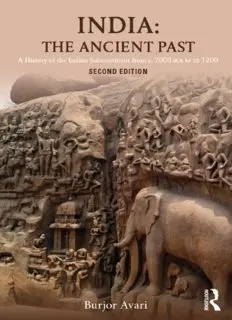
India: The Ancient Past: A History of the Indian Subcontinent from c. 7000 BCE to CE 1200 PDF
Preview India: The Ancient Past: A History of the Indian Subcontinent from c. 7000 BCE to CE 1200
India: The Ancient Past India: The Ancient Past provides a clear and systematic introduction to the cultural, political, economic, social and geographical history of ancient India from the time of the pre-Harappan culture 9,000 years ago up until the beginning of the second millennium of the Common Era. Through topics such as the Indus- Saraswati civilisation, Vedic and heterodox religions, the political economy, and social life in the Indian kingdoms, the book engages with methodological and controversial issues. This fully revised and updated second edition includes: • three new chapters examining the differences and commonalities between the north and the south of India; • extended discussion on contested issues, such as the origins of the Aryans and the role of feudalism in ancient India; • new source excerpts to introduce students to the most significant works in the historiography of India, and questions for discussion; • study guides, including a list of key issues, suggested readings and a selection of Internet sources for each chapter; • specially designed maps to illustrate different time periods and geographical regions. This richly illustrated guide provides a fascinating account of the early development of Indian culture and civilisation that will appeal to all students of Indian history. Burjor Avari MBE is Honorary Research Fellow in the Department of History at Manchester Metropolitan University. He has taught history at school and university levels for over five decades. His previous publications include Islamic Civilization in South Asia: A History of Muslim Power and Presence in the Indian Subcontinent (Routledge, 2013). India: The Ancient Past A history of the Indian subcontinent from c. 7000 BCE to CE 1200 Second edition Burjor Avari Second edition published 2016 by Routledge 2 Park Square, Milton Park, Abingdon, Oxon OX14 4RN and by Routledge 711 Third Avenue, New York, NY 10017 Routledge is an imprint of the Taylor & Francis Group, an informa business © 2016 Burjor Avari The right of Burjor Avari to be identified as author of this work has been asserted by him in accordance with sections 77 and 78 of the Copyright, Designs and Patents Act 1988. All rights reserved. No part of this book may be reprinted or reproduced or utilised in any form or by any electronic, mechanical, or other means, now known or hereafter invented, including photocopying and recording, or in any information storage or retrieval system, without permission in writing from the publishers. Trademark notice: Product or corporate names may be trademarks or registered trademarks, and are used only for identification and explanation without intent to infringe. First edition published 2007 by Routledge British Library Cataloguing-in-Publication Data A catalogue record for this book is available from the British Library Library of Congress Cataloging-in-Publication Data Names: Avari, Burjor, author. Title: India : the ancient past : a history of the Indian subcontinent from c. 7000 BCE to 1200 CE / Burjor Avari. Description: Second edition. | New York, NY : Routledge, 2016. | “First edition published 2007.” | Includes bibliographical references and index. Identifiers: LCCN 2015042418| ISBN 9781138828209 (hardback : alk. paper) | ISBN 9781138828216 (pbk. : alk. paper) | ISBN 9781315627007 (ebook) Subjects: LCSH: India – History. | India – History – 1000–1526. Classification: LCC DS451 .A87 2016 | DDC 934/.01 – dc23 LC record available at http://lccn.loc.gov/2015042418 ISBN: 978-1-13882820-9 (hbk) ISBN: 978-1-13882821-6 (pbk) ISBN: 978-1-31562700-7 (ebk) Typeset in Times New Roman by Florence Production Ltd, Stoodleigh, Devon, UK Dedicated to the memory of my dear parents, teachers and good friend David Melling. A vision for India Where the mind is without fear and the head is held high; Where knowledge is free; Where the world has not been broken up into fragments by narrow domestic walls; … Where the clear stream of reason has not lost its way into the dreary desert sand of dead habit; … Into that heaven of freedom, my Father, let my country awake. (From Gitanjali, by Rabindranath Tagore, Nobel Laureate, 1913) Contents List of excerpts List of illustrations Preface to the second edition Preface to the first edition Acknowledgements Synopsis 1 Introduction Defining terms Why study ancient India? Time, space and people Sources of study 2 From Africa to Mehrgarh: the early prehistory of India Earliest phases of human settlement and activity The Neolithic Revolution and the rise of agriculture Development of proto-urban settlements in the late Neolithic period 3 The Harappan–Indus–Sarasvati civilisation Phases of progress in Harappan archaeology Understanding the Mature Harappan phase The demise of the Harappan civilisation 4 Who were the Aryans? Understanding the Aryans The Aryan expansion The Vedic world of the Indo-Aryans 5 Post-Vedic centuries The rise of the state system Persian and Greek intrusions The second urbanisation Dissent and heterodoxy Varieties of literature 6 The Mauryan state: imperialism and compassion Chandragupta Maurya and his court Ashoka and his Dhamma The Mauryan world 7 Between the Mauryas and the Guptas New dynasties and new centres of power The international trade of India New trends in Indian religions Secular literature, sciences and the arts 8 The era of the Imperial Guptas The empire and the emperors Gupta society: a world in transition Indian achievements in the Gupta period 9 Feudal north India The dynastic landscape Kingship in the feudal age Aspects of northern economy and society Arab and Turco-Afghan invasions of the north 10 The ascendancy of the south The dynastic landscape Kingship and authority in a southern kingdom The economy of the south Caste and gender in the south 11 Across north and south: cultural unity and diversity The religious landscape Art and architecture Literature and thought Cultural influences abroad Select glossary of Indic terms Select glossary of archaic Indic place names Classification of ancient Indian texts by subject Bibliography Index
